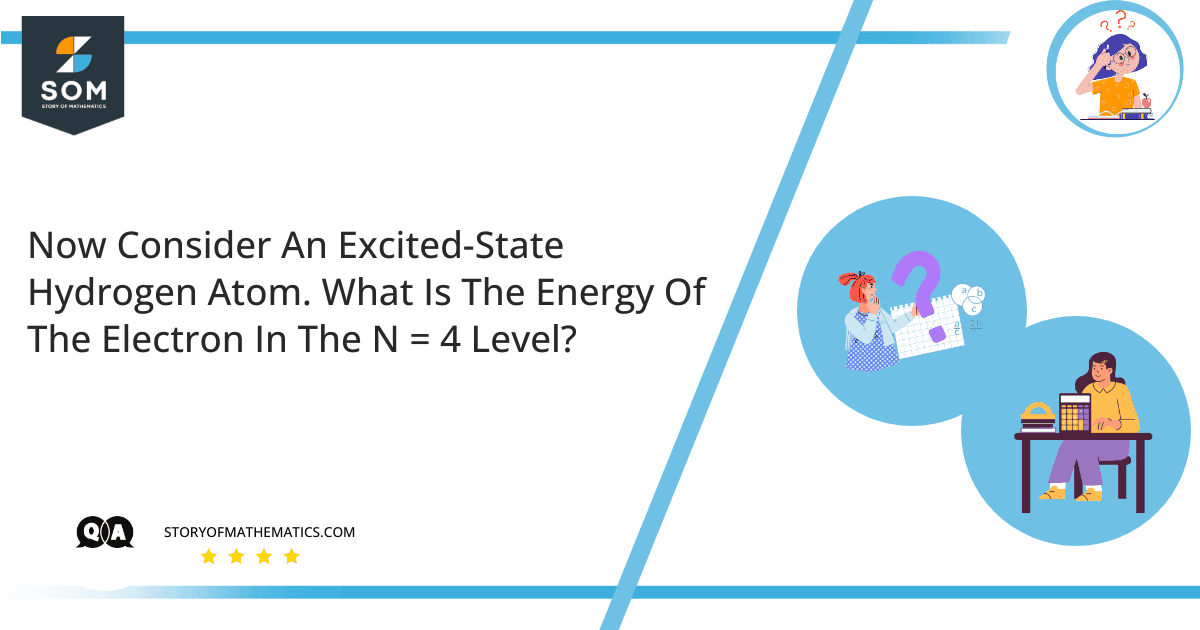
– Calculate the energy level of an electron in a hydrogen atom if it is considered to be in the ground state.
The aim of this article is to find the energy level of electrons in a hydrogen atom when the hydrogen atom is in the ground state and excited state.
The basic concept behind this article is Bohr’s theory of Energy Levels of Electrons.
Energy levels of electrons are defined as the points where the electrons may exist having fixed distances from the nucleus of an atom. Electrons are subatomic particles that are negatively charged, and they revolve around the nucleus of an atom in a certain orbit.
For an atom having multiple electrons, these electrons are arranged around the nucleus in orbits in such a way that the orbits closest to the nucleus have electrons with low energy levels. These Energy Level Orbits are expressed as $n-level$, which are also called Bohr’s Orbits.
As per Bohr’s Theory, the equation for energy level is given by:
\[E=\frac{E_0}{n^2}\]
Where:
$E=$ Energy Level of Electron in $n^{th}$ Bohr’s Orbit
$E_0=$ Energy Level of Electron in the ground state
$n=$ Energy Level Orbits or Bohr’s Orbit
Bohr’s Theory expressed the energy levels $n$ of a hydrogen atom, with the first orbit as level-1 which is described as $n=1$ and defined as being the ground state. The second orbit called the level-2 is expressed as $n=1$ and defined as the atom’s first excited state.
Expert Answer
Given that we have a hydrogen atom, we need to find the energy level of the electron in a hydrogen atom when the hydrogen atom is in the ground state and excited state where:
\[n=4\]
As per Bohr’s Theory, the energy level of the electron in $n^{th}$ Bohr’s Orbit is expressed as follows:
\[E_n=\frac{E_0}{n^2}\]
We know that the Energy Level of Electron in the ground state $E_0$ of the hydrogen atom is equal to:
\[E_0=-13.6eV\]
And for the ground state:
\[n=1\]
Substituting the values in the equation for Bohr’s Energy Level:
\[E_1=\frac{-13.6eV}{{(1)}^2}\]
\[E_1=-13.6eV\]
As the units for Energy are usually Joules $J$, so Electron Volt $eV$ is converted to Joules as follows:
\[1eV=1.6\times{10}^{-19}J\]
So by converting the units:
\[E_1=-13.6\times(1.6\times{10}^{-19}J)\]
\[E_1=-21.76\times{10}^{-19}J\]
\[E_1=-2.176\times{10}^{-18}J\]
For the excited state of the hydrogen atom, we are given as:
\[n=4\]
Substituting the values in the above equation:
\[E_4=\frac{-13.6eV}{{(4)}^2}\]
\[E_4=-0.85eV\]
By converting the units from Electron Volt $eV$ to Joules $J$ as follows:
\[E_4=-0.85\times(1.6\times{10}^{-19}J)\]
\[E_4=-1.36\times{10}^{-19}J\]
Numerical Result
The energy level of an electron in a hydrogen atom in the ground state is as follows:
\[E_1=-2.176\times{10}^{-18}J\]
The energy level of an electron in a hydrogen atom in an excited state at $n=4$ is as follows:
\[E_4=-1.36\times{10}^{-19}J\]
Example
Calculate the energy released in a hydrogen atom when an electron jumps from $4^{th}$ to $2^{nd}$ level.
Solution
The energy that is released in a hydrogen atom when an electron jumps from $4^{th}$ to $2^{nd}$ level is calculated as follows:
\[E_{4\rightarrow2}=\frac{E_0}{{n_4}^2}-\frac{E_0}{{n_2}^2}\]
\[E_{4\rightarrow2}=\frac{(-13.6)}{{(4)}^2}-\frac{(-13.6)}{{(2)}^2}\]
\[E_{4\rightarrow2}=(-0.85eV)-(-3.4eV)\]
\[E_{4\rightarrow2}=2.55eV\]
By converting the units from Electron Volt $eV$ to Joules $J$ as follows:
\[E_{4\rightarrow2}=2.55\times(1.6\times{10}^{-19}J)\]
\[E_{4\rightarrow2}=4.08\times{10}^{-19}J\]
